A New Beginning
Northern Division Club had originally been formed back in 1903 when district cricket was introduced. Even after this system was abandoned in 1911, the Club still continued on with the same name.
In 1947 the Association once again introduced a district system of cricket, whereby players were obliged to play with the Club in the district where they resided. The boundaries of the seven District Clubs were clearly defined. Northern Districts’ Club boundaries were “on the west by the old Bolwarra shire boundary, thence on the south by the Hunter River to the track joining the Paterson and Hunter Rivers at Phoenix Park, thence the Paterson River to the Wallalong crossing, thence a direct line to Bowthorne, thence north to the Woodville-Seaham road, thence a line due north”.
For the new Northern Districts Club, the change did not involve any major upheavals. The Club was fortunate in that it had already established a strong district identification and this had continued even after district cricket was abandoned.
Apparently, there was an attempt to retain a separate identity for the old Northern Division Club, but it did not take long for the old to merge with the new.
The new club more or less took over from the old Northern Division Club which supplied most of its players and executives. As the first Annual Report for 1947-48 of the new Club pointed out: “Having as our guardian angel, the old Northern Division C.C., we were slightly more fortunate than those Clubs such as Western Suburbs which had to start from scratch.”
All that was really involved was a name change and the loss and gain of a few players – Noel Proctor for example was lost to Western Suburbs, while Ernie Kent was gained from Robins Club.
Early Major Success
In its initial season (1947-48) Northern Districts Club was very successful. Their first and second grade finished the season undefeated. However, the firsts had to share the title of joint premiers with Central (formerly Robins) which with more outright wins finished equal on the points table. The second grade “carried all before them” and with the exception of one match had outright wins against all teams.
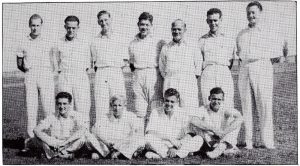
The first grade won their final against Central in a closely fought match that extended over four Saturdays, while play in the second-grade final was abandoned after the first two days’ play was washed out.
The Club also won the Club Championship – a new competition introduced in 1947-48 based on the point score of the three grades in district cricket. The outcome hinged on a deferred third-grade match which was won outright by Northern Division.
For the next three seasons (1948-51) the Club did not have the same level of success. Their first grade was shaded by the strong Central team which with players of the calibre of Mick Hinman, Ross Macmillan, and the Denny brothers won three successive premierships and two finals. However, the Club did win the third-grade premiership in 1949-50 and the Club Championship in 1950-51.
The last five seasons of district cricket (1951-56) were to be among the most successful in the history of the club and were to match the successes of the late twenties and early thirties.
From 1952-56 the first grade under the captaincy of Col Johnston won four consecutive premierships. They also won two first grade finals in 1951-52 and 1952-53 before finals were abandoned up until 1957.
Testimony to the Club’s first-grade strength was that after the introduction of district cricket in 1947, they participated in five of the six finals and won three of them.
During this short period of district cricket, the first grade was a particularly strong combination. Spearheaded by the pace attack of Norm Mudd and Keith Smith, with the backup spin at various stages of Merv Osborne, Charlie O’Connor, Aub Newman, and David Rutherford, together with a strong batting line.-up headed by the experienced Colin and Alan Johnston, the team formed a formidable and well-balanced unit. They were also fortunate in having a blend of senior players such as Brian Price, Jim Lindsay, Norm Dolman, Ernie Kent, George Wolstenholme Snr. and Doug Rawling, together with a crop of promising youngsters such as Mick Cummins, Max Stuckings, Peter Ross, Bill Stuckings, Doug March, Paul, and Peter Maher, who made their way into first grade.
Added to the first-grade success was a second-grade premiership in 1951-52 and three more Club Championships from 1951-54, making it four in a row.
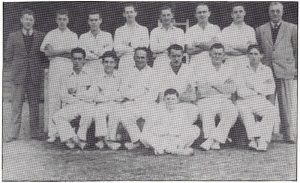
Seated (Left to Right): J. Maher, Paul Maher, J. Lindsay, R. Norrie (Captain), R. Moylan, M. Osborne
Front: B. Maher
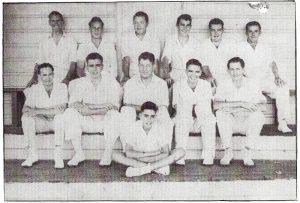
Conditions at Lorn Park
During the period of district cricket (1947-56) conditions at Lorn Park were not always up to the standard that had been reached prior to and during the war.
The ground suffered from the effects of a series of wet seasons culminating in the 1955 flood which inundated the ground and pavilion. To help offset the damage and losses caused by the flood, the Club received a grant of twenty-five pounds from the Flood Relief Fund. The Club also had difficulty in obtaining the services of a full-time curator.
For a number of seasons, the Club had to rely on the volunteer efforts of a small number of team members to prepare the wicket – not a very satisfactory situation.
The use of the ground by the Maitland Rugby Union Club during the off-season created problems. The 1947-48 Report noted: “At the conclusion of cricket the ground was in very good order, but since then, constant football has played havoc with the surface. Whilst football may not affect the wicket, which would probably be top-dressed in any case, the ground receives no attention whatsoever during the football season. ln future some arrangements will have to be made to ensure that the ground is not overworked and that those sports which cause the surface of the ground to become rough, bare and uneven do something to put the area back into shape.”An approach was made to the Rugby Club in an attempt to overcome these problems but to no avail.
An effort was also made to have extensions built onto the pavilion. An approach was made to Maitland City Council but because the additions would have involved too heavy a financial commitment by the Club, the proposals fell through.
One improvement that did take place was that in 1950-51 the Council for a set fee took over responsibility for the mowing of grounds. Prior to this, the Club had been fortunate in having Norm Mudd’s motorised mower to keep the outfield at Lorn Park in reasonable condition but too often, other grounds, particularly those at Maitland Park were overgrown with long grass and littered with cow dung that made playing conditions difficult.
Another sightscreen was erected – this time at the Bowling Club end. New practice nets were also obtained and the Club had a water roller made at a cost of forty pounds.
That similar problems have occurred over the years is evident from a gentle chiding given to Club members in the 1955-56 Report: “The Club, during last season, held one or two working bees to get the wickets and sheds in good order, but the attendance of members on these occasions was very disappointing indeed. The work that has to be done each year on the ground itself should not have to be done by the same few, season after season, as has been the result in the past. The committee would like to urge all members whenever possible to attend these little working bees and thus lighten the task for all concerned.”
Junior Development
This period saw the Club move into the area of junior coaching classes, followed later by the fostering of junior teams.
In 1948-49 two experienced cricketers, Athel D’Ombrain and Ernie Kent, started junior coaching classes at Lorn Park on Sunday mornings. These were conducted for three seasons and were open not only to youngsters from the Northern Districts area but to all-comers. The 1950-51 Report stated: “Since the inception of the scheme, they (A.D’Ombrain and E.Kent) have done a grand job for the young cricketer, and last season, in our own Club as well as in others, we noted the results.”
When the Maitland District Junior Association under the auspices of the Police Boys Club introduced in 1953-54 an Under 15 junior competition on Saturday mornings, a junior team from Lorn under the guidance of Bill Connery was entered. ln 1955-56 when Bill had to give up looking after the team because of business commitments, the Club stepped in and took over the running of the team. The 1955-56 Report records that in the junior presentations “the honour cap was won by Neville March for the best and fairest player of the year and the cup went to Denis Smith for the most improved player during the season”.
These junior teams were to be the nursery for the development of many young Norths players and provided a stepping stone to the higher grades in the years ahead.
Norm Mudd
In the post-war period up until 1960, Northern Districts had in Norm Mudd and Keith Smith one of the best, if not the best, opening bowling attack in the history of the Club and the Association.
Norm Mudd lived only a stone’s throw from Lorn Park and so it was almost inevitable that he should link up with the Club. He first appeared playing first grade for the old Northern Division Club in the 1936-37 season when he headed the bowling averages with 6 wickets for 81 runs off 28 overs at an average of 13.5. The following season he headed the bowling aggregate with 27 wickets and improved on this in the 1939-40 season by taking 53 wickets at an average of 10.75 to head the Club’s bowling aggregate and average.

In one match against East Maitland in March 1940 he took a haul of 16 wickets with 8-42 in the first innings and 8-62 in the second to create a district record for the most wickets in a match – a record that was equaled, but not broken, by Mick Hinman in 1949.
During the war years (1942-45) Norm played with the Maitland team in the Newcastle competition. His best performances were in the 1942-43 season when he took 28 wickets, including 4 wickets (and a hat-trick) in one over against Wallsend, and the 1943-44 season when he took 35 wickets.
After the war, he was back in the 1946-47 season playing second grade with Northern Division. The following season he returned to first grade and began his long association with Keith Smith as part of the team’s opening bowling combination.
The 1947-48 Report noted:” … the fast men, Keith Smith, and Mudd was the main strength of the attack … The value of the opening attack can be gauged from the fact that on only one occasion during the season was an opening partnership of over 50 recorded against us and on that occasion, an injury prevented Mudd from bowling. Further, no less than 11 opening wickets were down before double figures had been scored.”
The report went on to describe Norm’s bowling: “Always accurate, his pace and swing were generally too much for the opposition, so that his remarkably consistent efforts must be classed as among the best ever seen from a fast bowler in this district at least. Possibly his greatest asset was his ability to produce a beauty at a vital stage. “Such a “beauty” he produced in the final against Central to bowl Mick Hinman in the second innings.
Norm struck the peak of his form in the five seasons from 1947-52 – at a time when he was over 35! During this period he headed the Club’s bowling aggregate and averages in four of the five seasons with more than 30 wickets in each season and an average of less than 8.
In 1948-49 when he had to bear the brunt of the bowling following an accident to Keith Smith he took 53 wickets at an average of 7.7 and was described as “always dangerous, no matter what the wicket or how many overs he had bowled”.
One of his most spectacular bowling spells was in 1950-51 when he took 8 for 9 in 7.7 overs to demolish Western Suburbs for a total of 19. He also took two hat-tricks – one against Wests in 1951-52 and the other against Easts in 1954-55.
In his bowling Norm was a fierce competitor and liked nothing better than to encounter a new player with a reputation – “We’ll see how good he is, “he would say and proceed to let him have everything. As far as Norm was concerned there was no such thing as a good batsman – merely a lucky one!
Norm was “no slouch” with the bat. Col Johnston later recalled Norm’s effort in a match against East Maitland back in 1940 when Norths had to win outright to have any hope of winning the competition: “Although we led on the first innings, this was not good enough. Norm bowled through Easts’ second innings to take 8-62. We had to get 150 odd in 75 minutes. I said it could not be done. Norm had different ideas and despite his long bowling spell, insisted on opening the innings with me. He hit three lofted straight fours in the first over. Taking my cue from him, I managed to do the same in the second over. We won with 10 minutes to spare.”
At a later stage Norm ‘became the opening batsman in the 1949-50 season and “had a fine succession of useful scores”.
Norm continued to play first grade up until 1960. After a break of a couple of seasons, he returned to play third grade. He still had a lot of success with bat and ball up until 1968 when he retired to “become one of ‘Firsts’ Best Critics’.”
In his heyday, Norm represented the Association in John Bull Shield and Coal Board Cup matches and was a Hunter River representative at Country Week in 1948-49.
Apart from his deeds on the cricket field Norm was the club mechanic and curator – at one stage in the fifties he was listed on the Club Report as the “Ground Steward”. While other Club members merely played the game, Norm was a “worker” – a practical man who spent countless hours constructing, repairing, and maintaining club equipment. Mention has already been made of the motorised mower that he constructed for Lorn Park and his work in putting up one of the sightscreens. Another of Norm’s mechanical creations was a motorised roller that was built in the late 1970’s.
Norm spent a lot of time preparing wickets at Lorn Park. As a fast bowler and curator, his formula for a good wicket was “one that was rolled hard and fast and had a bit of life in it”.
Norm never wavered in his loyalty to the Club and in his later years with old teammates, Col Johnston and Keith Smith, rarely missed watching the club matches at Lorn Park. His family’s association with the Club continued on at a later stage with his two sons, Don and Alan, together with his grandson, Chris, all playing for the Club.
Keith Smith
Keith Smith came to the Club in the pre-season “try-out” in September 1946.
Col Johnston remembers him as “slim and fair, shy and unassuming and wearing the uniform of the RAAF from which he had not then been discharged”.
A Mercury reporter who sighted him at a pre-season practice described him “as a bowler of pace with a nice easy action … He also knows how to play shots and moreover, is a grand fieldsman”.
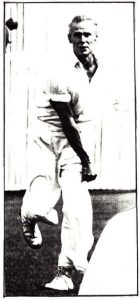
The Club Report of that initial season records: “We managed to annex the first-grade premiership … Keith Smith was the team’s outstanding personality. Still very young and previously without experience, he developed into a fine medium pace bowler … Until Christmas, he had taken only twelve wickets but after the break, secured thirty-four for the remainder of the season. His performance of 6 for 10 against Branxton was outstanding. He is a very good field and his batting will develop in a season or two.”
The following season (1947-48) he teamed up with Norm Mudd to take 21 wickets and in the words of the Report “no afternoon was too long for him to bowl a few more overs or to chase balls to the boundary”. ln the final against Central, after having 0-15 from 10 overs, he came back and in his second spell of 11 overs took 5-33 – “a fine performance on an unsympathetic wicket”.
At Country Week during the same season he had “one marvelous performance” when “on a perfect wicket” he took 5-14 from 14 overs and 3-9 in the second innings. His opening partner at this Country Week series was a young left-hander from Gosford – Alan Davidson – who was to go on to an outstanding Test career. At the end of the five matches at the Carnival Keith had slightly better bowling figures.
Then came season 1948-49. The Report tells the story: “We lost several players because of residential qualifications. Severe as these losses proved, they were not as great as the loss we suffered in the shocking accident which caused Keith Smith to have his left forearm amputated. Besides being a bowler of real promise, he was one of the finest clubmen. He displayed excellent form early in the season and had a successful trip to Country Week. On his return he suffered his accident and, after a long and gallant fight, amputation became necessary. We are pleased to say that before the season was over, Keith played in a social game or two and gave members valuable practice.”
Next season -1949-50, Keith made a courageous – comeback to first-grade cricket and took 30 wickets at 8.6. The Report for that season states: “AII will know of the remarkable return to cricket by Keith Smith. Having lost his left forearm, Keith was very different about playing first grade.
He came through the ordeal and for Keith, it was no doubt an ordeal, with flying colours. He had lost little of his pace and accuracy and was by no means the worst fieldsman. Moreover, he scored valuable runs. lt is felt that Keith will be a valuable member for many years to come and we congratulate him on his fortitude and doggedness.”
A crucial moment for Keith came in the first match against Wests when Bob Conlin went for a lofted drive. ln Col Johnston’s words: “The result was one of those tall skyers to deep mid-off which look so easy except to the fieldsman waiting underneath. Keith circled under it and I’m sure everybody held their breath. He grabbed it safely to his chest.” Who knows what the future might have been for Keith if he had dropped that catch?
Keith was to go on from strength to strength. ln 1950-51 he topped the Club’s bowling aggregate with 34 wickets and in 1952-53 headed the Club and District aggregate with 49 wickets – “no other bowler of any club getting within coo-ee of this figure”. In one match against Branxton in the latter season he took 6-8 off 5.1 overs.
For the next two seasons (1953-55) he was again the Club’s leading wicket-taker with 42 and 36 wickets respectively. Keith was to continue to play first grade up until 1971 – 24 seasons in all. His best seasons were probably from 1956-60 when he took over 50 wickets each season. ln 1956-57 he excelled taking 75 wickets at an average of 7.8. Including representative matches, he took over 100 wickets for the season to equal the previous achievement of Roy Oakes and Mick Hinman – a remarkable performance, particularly by a fast bowler!
It has been calculated that in his first-grade career Keith took 941 wickets at an average of 11.8! Col Johnston also points out that “as for the Club’s 1st X1, of the twenty seasons in which Keith Smith was at his best, the side won more than half the premierships and was out of the top two only once”.
In addition to club cricket, Keith was a regular representative for many years in the Association teams that played in the John Bull Shield and Coal Board Cup competitions. In 1950-51 he was back at Country Week and was “instrumental in winning matches”.
Despite losing his left forearm, Keith was still useful with the bat. ln order to get more strength into his shots, he adopted a left-handed stance and was so successful with this method that he was known on occasions to hook bowlers over the fence for six.
Another significant incident relating to Keith occurred in that first competition match against Wests after his accident. Batting last, Keith found himself facing the opening bowler, Bill Hughes. Perhaps, with good intentions, Bill “dollied” that first ball to Keith. This obviously upset Keith and he made it plain that this was no good to him. Wests’ captain, Eddie Hill, quickly summed up the situation and said, “Get into him”. Get into him they did and never again was there any suggestion of a bowler easing up when bowling to Keith.
Over the years he was to figure in a number of match-winning last-wicket partnerships. In the final of the Coal Board Cup against Gunnedah in 1950-51 he put on 30 with Alan Johnston for the last wicket to win the match “against a really good attack”. ln 1956-57 with Basil Johnston he created a new club record of 52 for the last wicket. In a match against Easts in 1958-59 Norths were 9 for 97 on a difficult wicket chasing 127. “With John Brown at No.11 manfully holding his end up, Keith batted as he had never batted before and made 26 not out with five fours, all lovely shots along the ground”.
After retiring from first grade in 1971 Keith played three seasons in second grade and a season in third grade and then after taking a short break, made a “comeback” in fourths for three seasons from 1977-80. Even in 1974-75 as recorded in the Club Report he was still a bowling force: “Playing his 29th season for the club and bowling from some four yards, Keith Smith’s control of length and direction was an object lesson to the younger players. He took 61 wickets and as statistics are not capable of doing so, only the good Lord can tell us how many this would have been if all the catches had been taken.”
Summing up Keith’s cricket career, one can hardly go past the words of his captain, Col Johnston “over thirty years Keith Smith has been an inspiration of skill and dedication, of sportsmanship and determination and above all, the courage of the highest degree.”
A Low Scoring Match
Both Keith Smith and Norm Mudd played in a remarkable low-scoring first-grade match against Weston Kurri at Chinamans Hollow at Weston at the end of the 1956-57 season.
In “perfect conditions” on a “bone-dry wicket” the scheduled two-day match was all over in one day.
Weston Kurri was dismissed for 29 and 38 while Northern District scored 19 (all out) and 3-54.
Keith Smith for Northern District took 5-16 in the first innings and 9-18 in the second, while Norm Mudd took 4-6 and 1-18. For Weston Kurri, Ken Bromage took 6-9 and Eric Burgess 4-8. ‘
In Northern’s first innings Basil Johnston top scored with 7 and the next best was Keith Smith with 5. Five “ducks” were registered by Col Johnston, Alan Johnston, Doug Rawling, Royce Levi, and George Wolstenholme Senior.
The Johnston Tradition Continued
The Johnston tradition was carried over from the old Northern Division Club to the new Northern Districts Club by Colin and Alan Johnston (sons of Will C.Johnston) and by Basil Johnston (son of Harold Johnston).
Colin Johnston began his competition cricket career at the age of 13 playing for Northern Division C grade in 1930-31. An astute Mercury reporter noted: “A Promising Boy … One of the most promising young bats at present in the District is Col Johnston, who is playing with Northern Division Third grade team. He has done well at High School and with his Club; he has even twice played right through the innings. Against Louth Park, on Saturday last he went in first and finished with 62 not out in a total of 119. Young Johnston has shown admirable qualities for an opening batsman. He is a left-hander and has an excellent defence. He watches the ball well and, when making a stroke, meets the ball with a full bat and gets behind it. He has shown he can stick it in a critical position.”
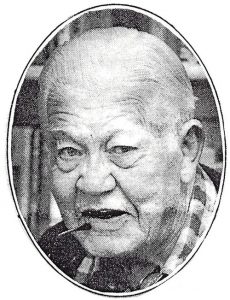
After another season in C grade, he made his A grade debut in 1932-33 and soon established himself as an opening batsman and wicketkeeper. From 1935-37 when he went to Sydney to learn the basics of the shoe trade he played with Mosman Club.
On his return to Maitland, he captained the A grade team and for the next three seasons (1938-41) headed the Club’s batting aggregate and average. It was during this period that Col scored his first century – 128 against Branxton in 1938-39 – and made the highest score of his career – 196 in that memorable match against Branxton in 1940-41. ln one of those strange quirks of cricket 1940-41 was also the season when he scored his one and only “pair of specs” (two “ducks” in the one match).
The pre-war period also marked the start of his representative career. He played his first district match in 1934 and after representing Hunter River at Country Week in 1938-39, was named as twelfth man for Combined Country.
Following the suspension of the local competition in 1941, Col had a short stint with Stockton for the remainder of the season and then played with the Maitland team in the Newcastle competition from 1942-47. During this time he figured in some fine opening partnerships with Mick Hinman. ln one match against Stockton at Lorn, Col, and Mick put on an opening partnership of 216 in 118 minutes, with Col ending up with 131.
Col had some fine batting figures in the Newcastle competition – 467 runs in 1943-44; 466 in 1944-45; and 596 in 1945-46. Further representative honours also came his way when he was selected to play for Newcastle against a Metropolitan X1 at the SCG in 1944 and against South Australia in 1946.
In 1946-47 he was named as captain of the Combined Country team to play Metropolitan at the SCG. He scored an impressive 141 not out for Combined Country and gained high praise from the Sydney press. Following on this innings he was chosen for N’SW Second X1 to play against Victoria at the MCG in December 1946. Shortly afterward he played for Northern NSW against Wally Hammond’s MCC team at Newcastle and captained the team after Reg Beatty withdrew following the death of his father after the first day’s play. lt was a proud moment for Col as his father had captained the team that played against Arthur Gilligan’s MCC team in Maitland in 1925.
So, in 1947 when Col returned to play in the local Maitland competition and took on the position of first President of Northern Districts Club, as well as the captaincy of the first-grade team, he brought with him an impressive background of experience in competition and representative cricket. That background was to bear fruit not only in his own personal success but in the immense benefit to the Club in the years ahead.
In the first season of district cricket (1947-48) Col headed the Club and District aggregate with 508 runs including two centuries at an average of 56.5. He scored a further two centuries in representative matches to take his combined total for the season over 1000 runs and for the second consecutive season represented Combined Country against City.
For three consecutive seasons from 1953-56, Col headed the Club and District aggregate with 756 runs, 346 and 573 respectively.
Under Col’s captaincy, the first-grade team during the time of district cricket (1947-56) won five premierships and three finals. The 1955-56 Annual Report paid him the following tribute: “He contributed fully to the team not only as a batsman … but also in the manner in which he captained the team. His record in being skipper for the four successive wins is in itself a fine marking stick on which his ability as a captain could be measured. He gave the team all he could on all occasions and the team as a whole responded really well to his calling.”
Col continued to captain the first-grade team until 1964-65. He held the position for 22 years and during that time the team won 11 premierships. He again headed the District batting aggregate in 1958-59 and 1960-61, scoring over 500 runs in each season.
On stepping down from the captaincy. Col had written: “Of course in the few playing seasons left ahead of me, I will play whenever chosen.” That “few playing seasons” was to extend to 1980-81 when he finally drew stumps after notching up the remarkable record of fifty-one seasons! After giving up the captaincy Col played first grade for another four seasons.
There were still glimpses of his former days of batting glory. John Cox, his successor as captain, wrote in the 1965-66 Report: “lt was pleasing to note that Col Johnston was second in the average with 33.0 and with an aggregate of 430 runs. Certainly, a smile will come to many old supporters when they remember his figures of previous years but I can assure you that Col’s batting is still a pleasure to watch when he gets going and I think that everyone will agree that his innings of 62 against Easts in the second round were reminiscent of the days when he was really in the groove.”
After 1969 Col moved down the line through seconds and thirds to finish his playing days in fourths with some of his former first-grade teammates. The 1980-81 Report of the fourth-grade team noted: “Col Johnston was not quite as successful with the bat this year but he enjoyed each game. We all look forward to his participation each Saturday, and his advice to the younger players does much to improve their performances.”
It has been calculated that during his long cricket career Col scored over 15,000 runs in first-grade cricket, including 24 centuries.
In the prime of his career, he regularly captained Maitland District teams in the John Bull Shield and Coal Board Cup competitions, the Hunter River teams that participated in Country Week, and the representative teams that played against numerous visiting sides, such as the Chegwyn X1’s and Miller’s NSW Shield team in 1955. He also toured Tasmania with an NSW Country team in 1954-55; went on an Old Collegians World Tour in 1960-61; and toured NZ with Peter Philpott’s X1 in 1970-71.
Besides his deeds on the cricket field, Col put a tremendous amount of work into the administrative side of the Club. He was Secretary of Northern Division Club (1937-41); President of Northern Districts Club (1947-55); a Committee Member (1955- 72); and Club Patron (1977-89). ln addition on the wider level he was President of the Maitland and District Cricket Association for a record 19 years (1955-73) and President of the Hunter Valley Cricket Council for a record 18 years (1956-73).
As a result of his work for cricket Col was honoured in various ways: an MBE in 1977 for his services to sport and the community; Life Membership of Norths Cricket Club, the Maitland and District Cricket Association, and the Hunter Valley Cricket Council; the naming after him of the pavilion at Lorn Park where he played so much of his cricket; the renaming of the cricket complex at Mt.Pleasant Street as the Johnston Reserve; the presentation of a special plaque by the NSW Country Cricket Association for his services to country cricket; and a Tribute Night accorded to him by the Association in 1989 in recognition of his services as a player and administrator for over 50 years.
Behind Col’s participation and involvement in cricket was a boundless enthusiasm for the game. In his own words he was an “obsessed cricket fan” – one for whom cricket was a passion – not just a game to be played or a sport to be administered but a way of life.
Those who knew Col and have heard him reminisce about cricket would appreciate that he was a real cricket enthusiast who had a wealth of cricket knowledge and who was deeply imbued with a love of the game, its history, and traditions.
On the field, Col was a determined competitor with a “never say die” attitude, no matter how seemingly hopeless the state of the match might be. However, while he played the game hard, he always played it in the best sporting manner. “When you play, you play to win, “he used to say, “but when the game’s over, that’s it” – it was time for a handshake and a convivial drink.
Later in life when reflecting on hi is long cricket career, he was able to say that he was proud of his years in cricket but prouder still that he was not aware of having made one enemy in all those years. He was grateful, too, for the enjoyment and satisfaction that he had got out of the game and for the many friendships that cricket brought his way.
George Wolstenholme Senior, one of Col’s close friends, aptly summed up Col’s career:” Col’s magnificent record both on and off the field, his dedication to the game he loves and his leadership qualities can only be an example and indeed an inspiration to all cricketers of all ages. I’m sure in years to come the name ‘Col Johnston’ will be a Legend wherever cricket is played or discussed within this district. “He will certainly remain a legend in the history of Norths Cricket Club!
Alan Johnston
Alan Johnston started his cricket career with Northern Division in the early thirties while still at High School. He played in B grade in 1932-33 under the captaincy of his uncle, Harold Johnston, and the Club report mentions him as taking the most wickets.
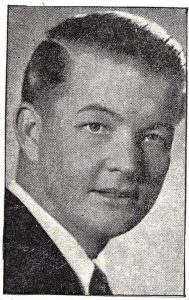
After a few seasons in the lower grade, he soon established himself in A grade as a batsman and off-spin bowler. ln 1936-37 his A grade batting average was listed as 16.2. The following season’s Report noted: “A.Johnston, not showing his best form until late in the season, won the aggregate and finished second in the averages with 299 at 27.1 besides getting the side’s best score with 79. However, his best innings was against Robins when, in drizzling rain, he scored a faultless 57. Johnston’s bowling fell right away, taking only 8 wickets for 232.”
In 1938-39 Alan gained his first representative honours when he played in an inter-Association match against Gloucester and was also in Hunter River’s Country Week team.
In 1940-41 he finished seventh in the district batting averages with 304 runs at 27.6.
During the war period, he played in the early stage with Stockton but later enlisted and as a lieutenant in the army with the 21st Machine Gun Regiment served overseas.
In 1946-47 he played with the Association’s team in the Newcastle competition and then returned to play with Northern Districts Club under the new district format.
During the nine seasons of district cricket (1947-56), together with his brother, Colin, he was to be one of the main batting strengths of the Club. ln fact during this time it was a case of either one or the other being top of the Club’s batting aggregate and average – Alan topped the aggregate and/or average four times while Col topped them the other five.
In two of those seasons – 1948-49 and 1951-52 – Alan headed the District aggregate with 538 and 482 runs respectively.
The 1948-49 Report gave high praise to his batting achievement for the season: “A.Johnston was the Club’s most reliable batsman and his figures are the best in the figures of all clubs. For 12 completed innings he scored 538 runs without the scoring of a century. This speaks volumes for his consistency and when one considers that the majority of innings were played on poorly kept grounds which kept scoring to a minimum, his eventual tally is hard to imagine if conditions had been in favour of scoring. His best effort was probably that versus Raymond Terrace when he scored 60 and 52 both not out. The match was played in shocking conditions for any grade of cricket with grass knee-high. Undoubtedly had a good scoring surface been provided he would have topped the century in each innings. His bowling was useful at times although he was not used overmuch.”
The Report for the previous season (1947-48), when he scored 447 runs at an average of 44.7 including a century against Central, claimed that “his best effort was undoubtedly that in the Final – also against Central”. In that final, which Northern won by 4 wickets on the fourth day. Alan with scores of 44 in the first innings and 52 not out was “the sheet anchor” and figured in two vital partnerships with George Wolstenholme Senior that helped the team recover from a very difficult position.
On the representative scene, Alan was in the Hunter River’s Country Week team for four consecutive seasons from 1946-50 and also played in the local Maitland team in the two matches against Chegwyn’s X1 in 1946. ln 1955 he was selected in the Hunter Valley team to play against Keith Miller’s NSW Shield team but unfortunately had to withdraw because of injury and his place was taken by another Northern Districts’ spinner, David Rutherford.
In the early post-war period, Alan also represented the Association in the John Bull Shield and Coal Board Cup competitions. In 1950-51 in the Coal Board Cup final against Gunnedah at Cessnock, he featured in a vital last wicket partnership that brought victory to Hunter River: “On this occasion, two of our players, Alan Johnston and Keith Smith, were responsible for a last-wicket stand of about 30. Incidentally, on this occasion, Alan Johnston scored 60 not out of 110. Against a really good attack, his innings was a magnificent effort. Completely chanceless, he scored all round the wicket, hit hard, and farmed the strike astutely. lt was easily the best innings seen last year from a Hunter River player.”
With his off-spinners, Alan was also a useful bowler. In the period up to 1956, he regularly took 15-20 wickets each season. However, after 1955 more bowling success came his way, and in the two seasons from 1956-58, he took 45 and 46 wickets respectively. The 1956-57 Report noted that his bowling “with greater opportunity improved considerably and this compensated … for the loss of Rutherford in so many representative games”.
In 1958-59 he underwent a knee operation that put him out of action for half a season. Although restricted in his movement, he came back to record some very good performances with both bat and ball in the seasons prior to his retirement from first grade in 1968.
In 1961-62 he headed the Club and District bowling averages with 15 wickets at 6.0 and in the four seasons from 1963-67 took 20 wickets or more each season. He scored 291 runs in 1960-61; 365 in 1963-64; and even in his last first-grade season (1967-68) still tallied a respectable 232.
Alan also again put in some outstanding performances in the finals.ln 1963-64 in the final against Combined City he shared a “match-winning partnership” with John Cox. In another final in 1966-67 against Eastern Suburbs he figured in an “excellent middle of the innings partnership” with Robin Cotton and then “completed a great double with his bowling” which led to his captain, John Cox, commenting:” … although he did not finish with a great number of wickets, I doubt very much if the ‘Younger One’ of the Johnstons has ever had a better performance in a Final.”
Alan was also involved in the administration of the Club. He served on the Executive Committee from 1947-55 and 1961-67 and was Club President from 1955-61. ln recognition of his long period of service to the Club both on and off the field he was made a Life Member.
After stepping down from first grade, Alan played a couple of seasons in seconds before finally retiring during the 1971-72 season, bringing to an end a distinguished career that extended over forty years and one that proudly carried on the Johnston tradition.
Basil Johnston
Basil Johnston, son of Harold Johnston, was the third Johnston whose cricket career spanned the old Northern Division Club and the new Northern Districts Club. He joined Northern Division in 1936 at the age of 12. He later recalled that as the sport was so popular at that stage, he was lucky to get a game at the weekend and often had to be content with filling vacancies in C grade.
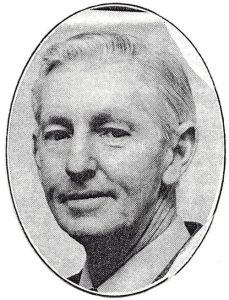
The 1938-39 Report shows that in C grade he took 2 wickets for 60 and had 14 innings for 59 runs. After leaving Maitland Boys High School in 1940 and working for two years at the Sydney firm of Farmers, he joined the Army and served four years in the coastal artillery and anti-aircraft units in New Guinea.
After his discharge from the Army, he returned to work in the family shoe business as a director and branch manager. He started playing cricket again with his old Club in the 1946-47 season and is mentioned in the C grade report as scoring 105 runs at an average of 26 and taking 5 wickets for 37.
From 1947-53 he played in second and third grade with Northern Districts. The 1947-48 Report noted: “B.Johnston, a very safe outfield, also will do better in future seasons when he overcomes his anxiety to score too quickly. He could probably pay attention to his bowling with good results. “The advice appears to have been heeded for the following season, after being dropped to third grade for the second half of the season, he finished on top of the third-grade batting averages with 228 runs at 28.5.
After showing some form in second grade, he was promoted to first grade in 1953-54. He spent four seasons in first grade before going back to captain the second-grade team from 1957-65. He then continued playing with the Club in second grade up until 1972.
Although his performances did not match those of his cousins, Colin and Alan, he had some very good seasons in second grade.
As the opener in 1958-59, he scored 414 runs and took 16 wickets. In 1963-64 “having his best season ever”, he topped the batting aggregate and average, finishing with 587 runs, including a century at 36.6. He followed this up in 1964-65 with 412 runs at an average of 27.4.
In a second grade match against Easts in December 1969 when the team amassed 397 he scored 97 and figured in a third-wicket partnership of 121 with Colin.
On four occasions he captained Maitland second grade representative teams that played against Newcastle. He was also active in a number of other sports. Cricket was his first love, but he played baseball, golf, squash, and tennis and was a keen fisherman.
Basil was actively involved in the administration of the Club. He served as Treasurer from 1950-56; as Secretary from 1956-63; and was Club President from 1963-73. In return for his long record of service, typical of the Johnston tradition, he was made a Life Member of the Club.
A Time of Change
At the 1956 Annual Meeting, the Association decided to abandon district cricket which had been introduced in 1947-48, and revert to club cricket where players could play with the club of their choice without any district residential qualification. The change was largely brought about by the 1955 flood that led to a population redistribution, making it very difficult for clubs such as Central to draw upon sufficient players from within their district boundaries.
At the same time, the name of the Association was changed from the “Hunter River District Cricket Association” to the “Maitland and District Cricket Association”.
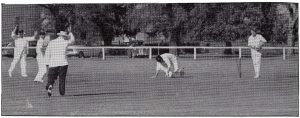
The First Grade Line Up
In 1964 when analysing the reasons for the Club’s remarkable post-war run of success in first grade where there had only been one season (1950-51) when they had not finished first or second,
Col Johnston pointed to three factors: “Firstly, of course, the ability of the players; secondly the team spirit that we have been fortunate to always have; and thirdly the policy of encouraging young players and bringing them on in company with the seniors.”These factors particularly applied to the decade from 1956-66.
Regular first-grade team members during this period were Colin and Alan Johnston, Keith Smith, Doug Rawling, Dave Rutherford, and Robin Cotton – players who provided a solid nucleus of experience in batting and bowling.
There were two main changes to the opening attack. Keith Smith continued on with his good form but following Norm Mudd’s retirement from first grade, John Brown took over Norm’s role of opening bowler in 1957-58.
John, a left-arm medium-pacer, came across from Methodist OK to try his luck in first grade after taking over 100 wickets in third grade the previous season. He took over 30 wickets in each of his first three seasons with the Club and followed this up with his best performance in 1960-61 when he headed the District bowling aggregate and average with 59 wickets at 7.7.
The other change in the opening attack came when Warren Trappel started playing with the Club in 1963-64. Another left-hander, he took over from John Brown and became Keith Smith’s regular opening bowling partner up until 1971.
For the first couple of seasons, the Club had the services of Roy Levi and Ken (Terry) Finch. Roy was a stylish wicketkeeper who won selection for Combined Country in 1956-57 while Terry was a talented batsman who later transferred to Eastern Suburbs and became in company with Ron Alien, one of the district’s best openers.
The team’s batting strength was also boosted in the early 1960’s by the Elliott twins, Colin and Allan, who were to become a real force in Maitland cricket. Allan was also useful with his medium-pace bowling while Colin was to become one of the best wicket-keepers in the State, thereby continuing a Club tradition of top-class wicket-keepers.
In addition to all of this talent, there were a number of promising youngsters who made their way into first grade. Among these were Jack Killer, Neville March, Glenn Brooker, John Archer, Arnold Roberts, Trevor Holden, Robert Robilliard, Jeff Crittenden, and Romney Newman.
Col Johnston continued on as captain of the team until the end of the 1964- 65 season. Having skippered the first grade for 22 seasons since 1937-38, he then stepped down and was succeeded by John Cox, an experienced campaigner who had come to the Club in 1963-64.
A String of Successes
During the first ten seasons of the return to club cricket (1956-66), Northern Districts Club again had considerable success.
In first grade the Club won four premierships – 1958-59; 1959-60; 1961-62; and 1962-63. In another season 1957-58 the first grade finished 15 points ahead of Western Suburbs but the Association in a somewhat unusual decision ruled that the winner of the final should be classified as the season’s premiers. This turned out to be Western.
Finals that had been abandoned for first grade after 1952-53 were re-introduced in 1957-58. In a remarkable record, Northern Districts’ first grade contested every final from 1957-66, winning four of them in succession from 1960-64. For the most part, the pattern was for the premiers to be defeated in the final, but in 1961-62 and 1962-63, the Club managed to complete the double by winning the premiership and final.
The Club only won one-second grade premiership during this period – in 1961-62 – but it did notch up its first third-grade premiership in the history of the Club. This was in 1964-65 when the team was captained by the veteran, Ken Smith, a former first-grade opening batsman who made a very successful comeback for a few seasons in the sixties. Much of the team’s success was due to Ken who scored 627 runs and to the left-arm spinner, Paul Moore, who took 73 wickets, including 50 before Christmas. Norm Mudd, the former “demon” first-grade bowler was also a member of this team and took 35 wickets.
The Club won four consecutive Club Championships from 1958-62 while the next four were won by Eastern Suburbs. The effort of Northern in winning these was particularly meritorious in that for three of the seasons the Club only had two teams and had to compete against other clubs with three teams
A Norths Identity
If ever a list of Good Samaritans for Norths was drawn up, then the name of Reg Kelly would have to be high on that list.

For almost twenty years Reg was identified with Northern Districts Club. Early references are made in the Club Reports of the 1940’s to Reg providing transport for the third-grade team. It is not long before some Reports show Reg as playing a few games – no doubt “filling-in” when the team was short.
Shortly afterward in the early fifties, he appears to be playing a full season with the thirds. In 1958-59 when the Club did not have a third-grade, he was the regular opener with Basil Johnston in second grade
He is referred to as “the veteran of many years” who “played in his usual solid style and although he only made 104 runs for the season, he shared in many good partnerships by holding up one end … he has threatened to retire but it is felt that next season will again see him at the nets”.
In the early 1950’s when the Club was struggling to find a curator, Reg took on the job for a couple of seasons.
However, Reg’s greatest value to the Club was in the advice and encouragement that he gave to the younger players. Dave Moreland, the third-grade captain in 1954-55, referred in his team report to the guidance of players like Fred McPherson, Geoff Pilgrim, and Reg Kelly: “These men who have the experience of years behind them were always prepared to assist the young and inexperienced members. In these men, the youngsters found batsmen who offered good examples of what is best in cricketers.”
When Norths entered a junior team in the Under 15 Saturday morning competition, Reg was one of those who looked after the team from 1957-65. The 1958-59 Report noted that Reg Kelly “saw that they played the game properly and ‘shouted’ them a party at the end of the season”.
Reg was also an active umpire and involved with the Police Boys Club.
In the mid-1970’s he moved north in his cream campervan to spend his later years in a warmer climate. Following his death, the Association learned that he had left a bequest in his will to be spent for the betterment of junior cricket in Maitland.



